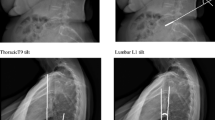Abstract
Summary
In a 12-year prospective study of 100 adult volunteers, incident vertebral fractures were analyzed for potential predictors. Decreased sagittal spinal curvature and pre-existing fractures were identified as independent predictors. The risk of vertebral fracture increased to 8.6-fold with a 1 SD decrease in both thoracic and lumbar curves.
Introduction
Physiological spinal curvature acts as a shock absorber: however, it has not been demonstrated whether reduced spinal curvature is a risk of vertebral fracture. The aim of this prospective study is to assess the relationship between the extent of sagittal spinal curvature and incidence of vertebral fractures.
Methods
One hundred community-based volunteers aged 50+ years were followed radiologically for at least 10 years. Entire spine radiograms of volunteers in erect position were used for evaluating sagittal spinal curvatures, grade of osteoporosis, and incident vertebral fractures.
Results
Mean baseline age was 61.9 years and mean follow-up period was 12.0 years. In multivariate analysis, preexisting vertebral fracture (relative risk [RR] 3.70, 95% confidence interval [CI] 1.22-11.20), and a decrease in either thoracic or lumbar curvature by 1-SD (RR 3.06, 95% CI 1.04-9.00) were independent predictors. The fracture risk even increased in the presence of a 1-SD decrease in both thoracic and lumbar curvature (RR 8.64, 95% CI 1.39-53.78).
Conclusions
Reduction of physiological curvatures in both thoracic and lumbar spine led to the increased risk of vertebral fracture by more than eightfold. The importance of evaluating sagittal spinal alignment should be emphasized, because it might indicate the risk of the first vertebral fracture, which is another strong predictor of subsequent fractures.



Similar content being viewed by others
References
Kapandji IA (1974) The physiology of the joints, vol 3, 2nd edn. Churchill Livingstone, New York, pp 20–21
Takemitsu Y, Harada Y, Iwahara T et al (1988) Lumbar degenerative kyphosis. Cinical, radiological and epidemiological studies. Spine 13:1317–1326
Kobayashi T, Atsuta Y, Matsuno T et al (2004) A longitudinal study of congruent sagittal spinal alignment in an adult cohort. Spine 29:671–676
Kobayashi T, Atsuta Y, Takemitsu M et al (2006) A prospective study of de novo scoliosis in a community based cohort. Spine 31:178–182
Committee for Diagnostic Criteria of Osteoporosis, Japanese Society of Bone and Mineral Research (2001). Japanese Journal of Bone and Mineral Research 8:76–82 (Japanese)
Gelb DE, Lenke LG, Bridwell KH et al (1995) An analysis of sagittal spinal alignment in 100 asymptomatic middle and older aged volunteers. Spine 20:1351–1358
Korovessis P, Stamatakis M, Baikousis A (1999) Segmental roentgenographic analysis of vertebral inclination on sagittal plane in asymptomatic versus chronic low back pain patients. Spine 12:131–137
Hammerberg EM, Wood KB (2003) Sagittal profile of the elderly. J Spinal Disord 16:44–50
Sinaki M, Brey RH, Hughes CA et al (2005) Balance disorder and increased risk of falls in osteoporosis and kyphosis: significance of kyphotic posture and muscle strength. Osteoporos Int 16:1004–1010
Schneider DL, von Muhlen D, Barrett-Connor E et al (2004) Kyphosis does not equal vertebral fractures: the Rancho Bernardo study. J Rheumatol 31:747–752
Mitra D, Elvins DM, Speden DJ et al (2000) The prevalence of vertebral fractures in mild ankylosing spondylitis and their relationship to bone mineral density. Rheumatology 39:85–89
Huang MH, Barrett-Connor E, Greendale GA et al (2006) Hyperkyphotic posture and risk of future osteoporotic fractures: the Rancho Bernardo study. J Bone Miner Res 21:419–423
Arnold CM, Busch AJ, Schachter CL et al (2005) The relationship of intrinsic fall risk factors to a recent history of falling in older women with osteoporosis. J Orthop Sports Phys Ther 35:452–460
Faulkner KG, Cummings SR, Black D et al (1993) Simple measurement of femoral geometry predicts hip fracture: the study of osteoporotic fractures. J Bone and Mineral Research 8:1211–1217
Opotowsky AR, Su BW, Bilezikian JP (2003) Height and lower extremity length as predictors of hip fracture: results of the NHANES I epidemiologic follow-up study. J Bone and Mineral Research 18:1674–1681
Yuan X, Takahashi N, Terashita T et al (1998) Which vertebrae should be assessed in diagnosing osteoporosis by plain radiography? Comparative study of radiographic findings and bone mineral density measured by dual energy X-ray absorptiometry. J Orthop Sci 3:252–256
Ross PD, Davis JW, Epstein RS et al (1991) Pre-existing fractures and bone mass predict vertebral fracture incidence in women. Annals of Internal Medicine 114:919–923
Pongchaiyakul C, Nguyen ND, Jones G et al (2005) Asymptomatic vertebral deformity as a major risk factor for subsequent fractures and mortality: a long-term prospective study. Journal of Bone & Mineral Research 20:1349–55
Author information
Authors and Affiliations
Corresponding author
Rights and permissions
About this article
Cite this article
Kobayashi, T., Takeda, N., Atsuta, Y. et al. Flattening of sagittal spinal curvature as a predictor of vertebral fracture. Osteoporos Int 19, 65–69 (2008). https://doi.org/10.1007/s00198-007-0432-y
Received:
Accepted:
Published:
Issue Date:
DOI: https://doi.org/10.1007/s00198-007-0432-y




